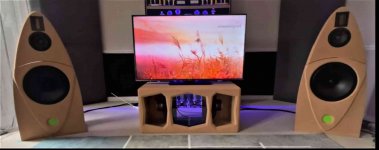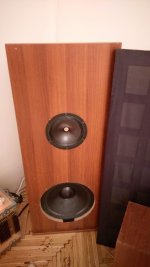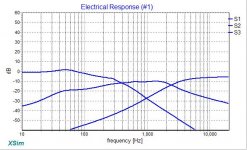Yes, I'm not sure if they are wax or oil types but they are on bass and midrange with Mundorf silver gold oil on the tweeter bypassed with soviet teflons.
Here is my latest open baffle design/build.
Very fancy wood-working there.
Nice! 😎
They can be also type МБГО (look all same), on western datasheets they are listed as paper in oil. I had open them, inside they are very wax like and on soviet datasheets they are пропитанная церезином - ceresin impregnated, what mean wax.Yes, I'm not sure if they are wax or oil types but they are on bass and midrange with Mundorf silver gold oil on the tweeter bypassed with soviet teflons.
Open Baffle Dipole Speaker Demo with Sennheiser Binaural Mic
- Acoustic Elegance, Mundorf, Zapco
This OB DIY system on Youtube is an example of a system that evolved in a way that seems to have aligned more with theory to get great results. Listen on headphones to match the binaural mic.
Open Baffle Dipole Speaker Demo with Sennheiser Binaural Mic - Acoustic Elegance, Mundorf, Zapco - YouTube
- Acoustic Elegance, Mundorf, Zapco
This OB DIY system on Youtube is an example of a system that evolved in a way that seems to have aligned more with theory to get great results. Listen on headphones to match the binaural mic.
Open Baffle Dipole Speaker Demo with Sennheiser Binaural Mic - Acoustic Elegance, Mundorf, Zapco - YouTube
Attachments
Here is my latest open baffle design/build.
Drivers are Beta15a, Seas U22 and Aurum Cantus G2si and there's a second tweeter on the rear as I prefer that to just a single front one.
My previous OB which was on a single, larger baffle used open-backed Mundorf AMT with Seas U18 and Alpha 15a and though I like the Alpha very much but the Beta does seem to sound cleaner. Overall the sound is very smooth, clean and transparent
Very nice build and woodwork! And frequency response.
The octagonal U baffle around the 15" seems to be working very well. How deep is the "U side" measured at the middle point from one of the octagon sides? Eyeballing, about 8" between small baffle, octagonal frame, and back wings?
Nice way of hiding a relatively large baffle from non-audio eyes! 😀
I like folded baffle shape for the property of minimizing a large shape blocking front wall reflections, and lowering the front surface area reflections.
Very nice build and woodwork! And frequency response.
The octagonal U baffle around the 15" seems to be working very well. How deep is the "U side" measured at the middle point from one of the octagon sides? Eyeballing, about 8" between small baffle, octagonal frame, and back wings?
Nice way of hiding a relatively large baffle from non-audio eyes! ��
Thanks. If I understand your question correctly the internal depth (front to back) of the octagonal sides is 6". The baffle is 1".
I like folded baffle shape for the property of minimizing a large shape blocking front wall reflections, and lowering the front surface area reflections.
Thanks, and yes, that was an important design objective.
Last edited:
TimA,
Can you please share some details about the crossover?
I would like to know how did you manage to get satisfactory bass with a passive crossover and Beta15?
I had an OB with Beta15, but could not get satisfactory bass until I actively crossed it at 80Hz (12 db/oct) plus a bit of EQ...
Thanks,
Vix
Can you please share some details about the crossover?
I would like to know how did you manage to get satisfactory bass with a passive crossover and Beta15?
I had an OB with Beta15, but could not get satisfactory bass until I actively crossed it at 80Hz (12 db/oct) plus a bit of EQ...
Thanks,
Vix
Here's the Xover. The electrical response in my original post shows the resultant bass contouring. Its possibly worth mentioning that the Beta cone has been treated with pva though I don't expect this has altered the bass performance significantly. My sub's roll in at 31 Hz with a 24dB/8ve slope and the bass is simply the best I've ever heard.
Attachments
TimA,
Can you please share some details about the crossover?
I would like to know how did you manage to get satisfactory bass with a passive crossover and Beta15?
I had an OB with Beta15, but could not get satisfactory bass until I actively crossed it at 80Hz (12 db/oct) plus a bit of EQ...
Thanks,
Vix
What size was your baffle?
Here's the raw (smoothed) Beta 15 when measured at 1.5m and mounted in my octagonal O.B. Also the filter response.
The upward sloping filter response does a pretty good job in compensating for the downward sloping Beta 15 response. Slightly more compensation is possible if necessary by enlarging the shunt capacitor, at the expense of reduced efficiency of course.
The upward sloping filter response does a pretty good job in compensating for the downward sloping Beta 15 response. Slightly more compensation is possible if necessary by enlarging the shunt capacitor, at the expense of reduced efficiency of course.
Attachments
Last edited:
I think it was 50 or 60 cm with 120 cm. They no longer exist, as I had changed residence, and the new apartment is unsuitable for OB, so I got back to boxed speakers...
The crossover I had was active, analog, 80hz low pass, 160 hz hi pass, (thanks to Nelson Pass) second order, with a bit of EQ at the bottom and a bit of correction for the fullrange...
I couldn't imagine that anyone could get out with a passive crossover on a Beta 15, shallow baffle, and still have bass...
The crossover I had was active, analog, 80hz low pass, 160 hz hi pass, (thanks to Nelson Pass) second order, with a bit of EQ at the bottom and a bit of correction for the fullrange...
I couldn't imagine that anyone could get out with a passive crossover on a Beta 15, shallow baffle, and still have bass...
Nice one!
Click for vid:
open baffle speakers - Eminence Alpha 15 A and TangBand W8-1808 on 6 Hypex ncore 400 - YouTube

Click for vid:
open baffle speakers - Eminence Alpha 15 A and TangBand W8-1808 on 6 Hypex ncore 400 - YouTube

Vix
Don't you think that your OBs were way too close to the wall?
If you use a big inductor and sacrifice some SPL any woofer can play bas.
Don't you think that your OBs were way too close to the wall?
If you use a big inductor and sacrifice some SPL any woofer can play bas.
Vix
If you use a big inductor and sacrifice some SPL any woofer can play bas.
Should have said at low decibels, 'cos crank it up and they will distort very quickly....
- Home
- Loudspeakers
- Multi-Way
- Ultimate Open Baffle Gallery





